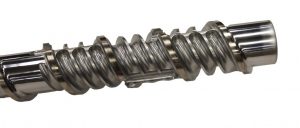
New extrusion screw mixing design targets highly filled resins
Canadian Plastics
Plastics Processes Raw Materials HandlingThe DS-Blend from Davis-Standard is a patent-pending design to improve the performance of a single-screw extruder.

Photo Credit: Davis-Standard LLC
Extruder supplier Davis-Standard LLC recently developed a new extrusion screw mixing element that is appropriate for challenging tasks, such as mixing high concentrations of fillers with plastic resin.
The DS-Blend is designed to improve the performance of a single screw extruder for demanding applications by providing distributive and dissipative melt mixing. The two-stage approach achieves outputs similar to those of a single-stage barrier screw, but with a lower melt temperature and reduced energy requirements. It can be installed on new or existing single screw Davis-Standard extruders as well as non-Davis-Standard brands.
“The DS-Blend is a patent-pending design to improve the performance of a single-screw extruder for difficult mixing applications,” said John Christiano, vice president of technology. “It’s used to provide both distributive and dissipative melt mixing.”
Distributive mixing involves homogenizing compatible melted resins, while dissipative mixing involves combining melted resin and unmelted material, such as fillers.
A typical application for the new mixing section would be mixing high concentrations of fillers, such as talc and calcium carbonate, with PP for sheet production. In those instances, the DS-Blend mixing segment is incorporated into the screw of a two-stage, vented single-screw extruder.
“The optimum, two-stage DS-Blend screw design achieved a similar output to a single-stage barrier screw, achieving a much lower melt temperature while using less energy,” Christiano said.
The result is a thorough mixing of PP with high concentrations of fillers and additives while controlling melt temperature. It also is ideal for use in mixing high-viscosity polymers, Christiano said.
The design “uses unique geometry to improve distributive and dissipative melt mixing performance,” he said. “This is accomplished by varying the channel geometry to improve mixing while reducing pressure drop. This helps to improve energy efficiency while maintaining a low melt temperature.”
Additionally, the number of channels, helix angles, and channel depths can be varied to optimize mixing performance.
